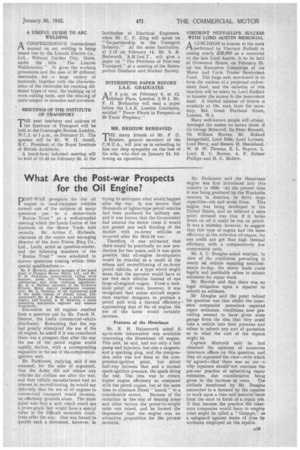What Are the Post-war Prospects for the Oil Engine?
Page 21

If you've noticed an error in this article please click here to report it so we can fix it.
POST-WAR prospects for the oil engine in road-transport vehicles formed one of the subjects of many questions put to a motor-trade " Brains Trust " at a well-attended meeting which the Leeds Centre of the Institute of the Motor Trade held recently. Mr. Arthur C. Richards, chairman of the centre and managing director of the Aero Piston Ring Co., Ltd., Leeds, acted as question-master, and the following members of the " Brains Trust " were scheduled to answer questions coming within their special qualifications:— Mr. F. Howarth, general manager of the Leeds depot of Paragon Motors (Hull), Ltd., and Mr. T. H. Parkinson. motor-vehicle rolling stock engineer, Leeds Cit v Transport Department (mechanical and other technical questions); Mr. A.L. Hndson, secretary of the Yorkshire Division, Motor Agents' Ass
M ociation (commer cial); r. L. Thomson, of the engineering staff of the Leeds branch of Joseph Lucas.Ltd. (electrical); Mr. E. J. Morrish, a Leeds solicitor ilegal); and Captain A. H. Haycock. a Leeds consulting automobile engineer and assessor (insurance).
Discussion on oil engines resulted from a question put by Mr. Frank H. Dutson, the 1.eeds commercial-vehicle distributor. Remarking that the war had greatly stimulated the use of the oil engine, he asked if it was considered -there was a prospect that after the war the use of the petrol engine would rapidly, decline, with a corresponding expansion in the use of the compressionignition unit.
Mr. Parkinson, replying, said if one assumed, for the sake of argument, that the Army did not release any vehicles for civilian use after the war, and that vehicle manufacturers had no interest in reconditioning, he would say . definitely that the use of oil engines in commercial transport would increase, on efficiency grounds alone. The main point was that a unit which could use a.lower-grade fuel would have a special value in the difficult economic conditions after the war. One was bound to qualify such a statement, however, in trying to anticipate what would happen after the war. It was known that thousands of lighter-type petrol vehicles had been produced for military use, and it was known that the Government had assured the Motor trade it would not permit any such flooding of the market with ex-Army vehicles as occurred after the 1914-18 war.
Therefore, it was estimated that there would be practically no new production for two years, and it was quite possible that oil-engine development would be retarded as a result of the release and reconditioning of ex-Army petrol vehicles, of a type which might mean that the operator would have to use two such vehicles instead of one large oil-engined wagon. From a technical point, of view, however, it was recognized that unless aircraft experience enabled designers to produce a petrol unit with a thermal efficiency approaching that of the oil engine, the use of the latter would certainly increase.
Features of the Hesselman Mr. R. H. Hainsworth asked if up-to-date information was available concerning the Hesselman oil engine. This unit, he said, had not only a fuel pump and injectors, but also a magneto and a sparking plug, and the compression ratio was not fixed at the compression-ignition point, but about half-way between that and a normal spark-ignition pressure, the spark doing the rest. The idea was to obtain higher engine efficiency as compared with the petrol engine, but at the same time to eliminate Diesel " knock " to a considerable extent. Because of the reduction in the size of bearing areas and other factors the power-to-weight ratio was raised, and he formed the impression that the engine was an attractive proposition for the private motorist. Mr. Parkinson said the Hesselman engine Was first introduced into this country in 1930. `At the present time it was being produced by the Waukesha concern in America, in fairly large capacities—six and seven litres. This engine was being developed in the United States, and he believed a sales point stressed was that if it broke down on oil it could be run on petrol. It was a mistake, however, to suggest that this type of engine had the same efficiency as the orthodox oil -engine, for one could not get that high thermal efficiency with a comparatively low compression ratio.
Mr. S. C. Douglas asked whether, in view of th..1 conditions prevailing in nearly all vehicle repairing establishments to-day, the motor trade could legally and justifiably refuse to submit estimates for repair work.
Mr. Morrish said that there was no legal obligation upon a repairer to submit an estimate.
Mr Douglas said the point behind his question was that whilst the insurance companies' procedure required repair estimates, conditions now prevailing seemed to have given some garage firms the idea that they could take a vehicle into their premises and refuse to submit any sort of quotation as to what the cost of the repairs might be.
Captain Maycock said he had obtained the opinions of numerous insurance offices on this question, and they all expressed the view—with which he agreed—that there was no rea why repairers should not continue the pre-war practice of submitting repair estimates, due consideration being given to the increase in costs. The attitude mentioned by Mr. Douglas amounted to a demand by the repairer to work upon a time and material basis from the start to finish of a repair job. If that became the practice the insurance companies would have to employ what might be called a " Gestapo." as a safeguard against waste of time by workmen employed on the repairs.




















































